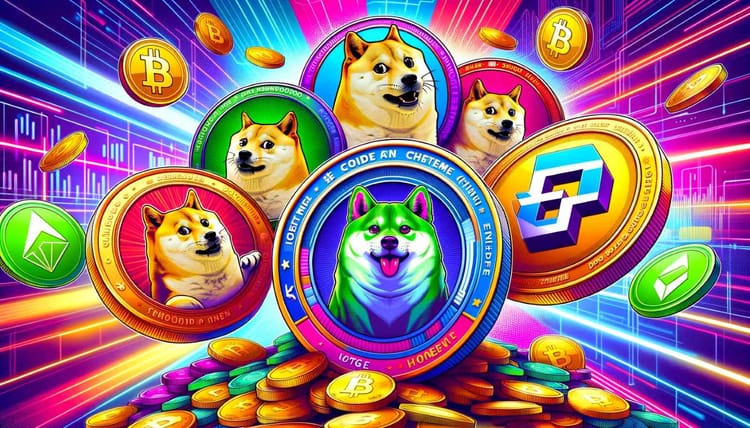Crypto Guide: A Look at the Trends, and Pros and Cons of Meme Coins for 2024

Cryptocurrencies have come a long way from their initial introduction in January 2009. Launched by a programmer or a group of programmers using the pseudonym 'Satoshi Nakamoto,' Bitcoin aims to decentralize payments using a public blockchain. As technology continues to evolve, cryptos have transcended their initial purpose of adding new use cases and even the emergence of "meme coins."
So, what are meme coins, and are they worthy of alternative investments to Bitcoin and Ethereum? First, let's get into the most obvious takeaway from meme coins—these cryptos can't compare to Bitcoin or Ethereum regarding use case potential and market value. While our two major coins are built for specific use cases intending to revolutionize traditional payment systems, meme coins are inspired by internet memes, satire, and jokes.
These cryptos often lack a solid white paper or long-term plans for usability. Instead, meme coins derive value from jokes, viral tweets, posts, and market messages. Most meme coins available in the market now lack specific purposes or use cases beyond the community. Also, many young traders and internet-savvy market participants favor most of these coins for quick market gains.
A deeper look into meme coins
As mentioned, meme coins are cryptocurrencies that started out from jokes or internet memes. Since they derive their values from jokes and passionate community support, they aren't backed by robust blockchain technologies. For some meme coin projects, the technology and their use cases have become an afterthought.
The first and most popular example of a meme coin is Dogecoin (DOGE), created as a joke in 2013 but has since gained traction and market capitalization. Dogecoin is an "accidental crypto," a product of an inside joke aimed at the ridiculous market speculation on cryptocurrencies during that time. Despite Dogecoin's satirical nature, many consider it a viable crypto and legitimate investment option. Dogecoin is a copy of Litecoin's code, and many use it to transfer value online like other digital assets.
The coin became popular in early 2021 when celebrities like Elon Musk, Snoop Dogg, and Mark Cuban backed and promoted the coin, sending observers and the investing public into a frenzy. In 2021, DOGE became one of the largest cryptocurrencies by market capitalization, with a total value of $80 billion, even though each coin is worth pennies.
Unlike Bitcoin, which was designed to be a scarce commodity through the halving mechanism, Dogecoin is abundant. With 10,000 new coins mined every minute, there's no cap on its supply. At today's prices, Dogecoin's market cap is $22.34 billion, still in the Top 10 list of the largest cryptos.
Other popular meme coins in circulation

Aside from Dogecoin, dozens of other meme coins are competing for the investing public's attention. Many are still in the conceptualization and development phase, and many of the newer coins don't run on their own blockchain networks.
Instead, they work as tokens supporting existing cryptosystems like Solana and Ethereum. This approach makes it easier for the developers to create a marketing strategy that taps into the underlying parent network's data security and transaction security. So, for someone who can't see through the white paper and the technical details, it can be a problem.
- SHIB. Shiba Inu is an Ethereum-based token aiming to replace or compete with Dogecoin. Unlike Bitcoin, which is now a scarce commodity, SHIB is designed to be abundant, with one quadrillion coins in circulation. Shiba Inu isn't just your average meme coin; its ecosystem supports projects like the NFT art incubator and hosts the decentralized exchange called Shibaswap.
- PEPE. Like most meme coins, PEPE is inspired by a popular internet meme featuring Pepe the Frog. This crypto is developed on the Binance Smart Chain, a light-hearted approach to differentiate itself from the common dog-themed cryptocurrencies.
- Bonk. Bonk is the first Solana-based dog coin, and 50% of its supply was airdropped to the Solana community. Its development is in response to the growing frustrations of many developers on the "Alameda" tokenomics.
- Floki Inu. Floki started as a meme but soon became a leading utility project. The crypto's ecosystem currently supports 3D NFT Metaverse, a crypto education project, a merchandise store, and DeFi utilities.
Meme coins, volatility, and their market value
Since these coins are community-driven and often based on viral tweets rather than utility, their value is mostly speculative and volatile. For example, when Elon Musk tweeted DOGE, its value jumped by around 4% after a few minutes. After Musk's tweet, the crypto's market value immediately increased to $0.072 from $0.069. After the hype and attention died down, its price fell.
Another reason for the volatility of meme coins is their design. Unlike fiat currencies, Bitcoin and Ethereum, meme coins have uncapped supply; thus, they're inflationary in nature. The exception here is Shiba Inu, which has a total supply of 1 quadrillion. Still, we're talking about many coins in the market, making them less scarce (and less valuable) than Bitcoin, which caps its supply at 21 million coins.
So, should you care and buy meme coins?
While meme coins are just a product of viral tweets with no solid use cases, these still serve a purpose today. These coins show the power of community, emotion, and sentiment in this modern age. As mentioned, their values are largely driven by social media buzz, endorsements, and the broader meme culture online. Yes, the financial risk of investing in these coins is high, but they're still an important aspect of our crypto market. Dogecoin, for example, has a market capitalization of over $22 billion, which is almost comparable to the Roblox market cap and well within the Top 1000 by market capitalization.
Here are some things you should remember about meme coins:
- Memes, internet jokes, and viral posts often inspire meme coins;
- These coins are highly volatile, and values change in minutes;
- Meme coins have uncapped supply, except for Shiba Inu;
- These meme coins have very low value.
A look at meme coins' future trends
Currently, meme coins are not widely adopted or used as leading cryptocurrencies. But that doesn't mean they are useless and should be avoided at all costs. As mentioned, meme coins are unique because of the passionate support they receive from their growing users, developers, and community. Also, a few trends and developments can favor meme coins and their community.
For example, reports suggest that many mainstream businesses have expressed openness to accepting meme coins as payments. Tesla by Musk, for example, has begun accepting DOGE as a payment method for certain items. Other companies like Twitch, Newegg, GameStop, and AMC are now slowly accepting Shiba Inu and Dogecoin as payments.
There's also a growing interest in utility meme coins, which are meme coins with a solid plan for usability online. A great example is Shiba Inu, which plans to develop the Shibaverse, a Metaverse for the Shiba Inu community. The team behind Floki Inu is also looking to enhance its token's utility to differentiate it from other coins. The Floki ecosystem will soon support a crypto education program and an NFT gaming metaverse called 'Valhalla.'
Finally, it's expected that the community, some investors, and plenty of retail traders will continue looking at meme coins as legitimate investments. Yes, these coins are highly volatile, but trading at the right price and time can lead to a huge profit potential. But if you plan to invest and trade meme coins, we recommend practicing due diligence. In addition to the materials here, it's best to double-check information on your own.




